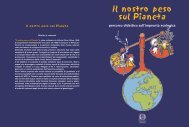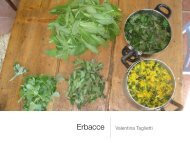Myanmar Protected Areas: Context, Current Status ... - Istituto Oikos
Myanmar Protected Areas: Context, Current Status ... - Istituto Oikos
Myanmar Protected Areas: Context, Current Status ... - Istituto Oikos
You also want an ePaper? Increase the reach of your titles
YUMPU automatically turns print PDFs into web optimized ePapers that Google loves.
Fauna and Flora checklist<br />
Many PAs have partial or complete checklists of some natural resources, due to research activities on<br />
specific topics carried out, or because resources identification is part of the annual operational plan.<br />
The most common checklists are those on mammals, trees and birds owned respectively by 25, 23 and<br />
22 of PAs. Fewer PAs (9-11) possess checklists on insects, amphibians and reptiles. The PAs which do<br />
more inventories of different biological resources are Indawgyi Lake Wildlife Sanctuary, Lampi Island<br />
Marine National Park, Alaungdaw Kathapa National Park, Chatthin Wildlife Sanctuary, Htamanthi Wildlife<br />
Sanctuary, Khakaborazi National Park, Panlaung-Pyadalin Cave Wildlife Sanctuary and Shwesettaw<br />
Wildlife Sanctuary. All these sites are managed by NWCD.<br />
3. Management<br />
In terms of management 20 PAs have a planning document, in most cases an annual operational plan,<br />
and park wardens have to report about its completion to headquarters at the end of every year.<br />
Patrolling, environmental education and wildlife surveys are implemented in approximately half of<br />
the surveyed PAs. Development actions performed by park staff include, in 23% of the visited sites,<br />
community based natural resources management and community forestry in the surroundings areas<br />
of the PA. Outreach programs are implemented in 30% of the PA visited, in form of collaboration and<br />
meetings with neighbouring communities, but also in terms of education programs. In 70% of the PAs<br />
visited, lack of budget and staff (both in numbers and quality) are mentioned as the main constraints<br />
to the implementation of management actions. Conflicts with local communities and insurgents are<br />
identified as main limit to management in 15% of the visited sites.<br />
4. Staff/Resources<br />
Over 65% of the sample has some infrastructure for management, at least the park warden office, and<br />
staff assigned with some level of training. In most cases physical and human resources were judged<br />
inadequate by PA authority or staff. There are 17 out of 43 PAs with no allocated staff and all are under<br />
the governance of FD. Staff is missing in all proposed areas except Bawditataung and Natma Taung.<br />
The number of staff allocated to remaining 26 sites ranges from a minimum of 4 for Kelatha to a<br />
maximum of 131 for Hlawga without any correlation to the size of the PA. For instance, only 17 staff are<br />
allocated to the largest (Hukaung Valley, 22.000 km²) and over 30 to the smallest (Lawkananda, 0,5 km2 ).<br />
In general, PAs governed under NWCD have more infrastructure and staff, and consequently perform<br />
more conservation and management activities than those governed by FD, where the office is in general<br />
quite far from the PA and management actions are limited to sporadic patrolling and gap planting.<br />
Lack of financial resources is reported as the main cause of insufficient monitoring and patrolling; staff<br />
is not paid any travel allowance and vehicles and tools are inadequate.<br />
5. Tourism<br />
Tourism is permitted in some PAs, especially those that are listed among the <strong>Myanmar</strong> ecotourism sites<br />
(Moyingyi, Popa, Shwesettaw, Inlay Lake, Alaungdaw Kathapa, Natma Taung, Khakaborazi, Hponkanrazi,<br />
Mainmahla Kyun, Lampi Island, Hukaung Valley, Chatthin). Furthermore, religious tourism is present in<br />
other areas such as Kyaikhtiyoe, Bumhpabum and Par Sar. Tourism facilities are available in 19 sites but<br />
tourism statistics were not available at the park offices because they are managed under the <strong>Myanmar</strong><br />
Travel and Tourism. No community-based tourism activities were recorded inside or in the proximity of<br />
protected areas except for Inlay lake, which is one of the main tourist destinations in <strong>Myanmar</strong>.<br />
Figures for international tourism are very small for <strong>Myanmar</strong> compared to neighbouring countries but<br />
more investments are expected in the future, with special attention to ecotourism.<br />
6. Land use and Human activities<br />
Land use classification consists of 10 categories according to Young (1994) namely: 1) not used 2)<br />
conservation 3) collection 4) forestry 5) agricultural production 6) fisheries production 7) recreation 8)<br />
mineral extraction 9) settlement 10) use restricted by security. Data confirm that agricultural production,<br />
forestry and fisheries production are implemented in the majority of protected areas. Tourism and<br />
recreation areas are present in 32% of the analysed PAs, mining activities are reported in 10 sites, and<br />
security issues related to the presence of either insurgents or army compounds inside 6 sites.<br />
<strong>Myanmar</strong> <strong>Protected</strong> <strong>Areas</strong><br />
7. Research<br />
Research surveys have been implemented in 65% of sites, mainly by local universities, local NGOs<br />
and a few international organisations (WCS, California Academy of Science, Smithsonian Institute,<br />
<strong>Istituto</strong> <strong>Oikos</strong>). There are no clear procedures to undertake research in the PAs. Local researchers make<br />
agreements with park wardens while international scientists are required to get security clearance from<br />
the central FD office. Furthermore, research results are often not available at the park office.<br />
2.3 <strong>Protected</strong> <strong>Areas</strong> Datasheets<br />
In the following section, we report the general information provided by Forest Department and the<br />
maps produced by project GIS experts for all 43 PAs and selected information collected by the project<br />
on natural resources, threats, management, tourism, land use and human activities, research, about<br />
the 30 surveyed sites. All the information retrieved during the project has been inserted in a database<br />
available to stakeholders upon request. Such database has been created using MS Access 2007 and<br />
comprises a Graphic User Interface to easily browse all the <strong>Protected</strong> <strong>Areas</strong>. The instructions on how<br />
to use the Database are present in the Database itself. The maps displayed in the present publication<br />
have been created using data retrieved from different sources such as: SRTM for the digital elevation<br />
model (USGS 2004, Shuttle Radar Topography Mission, Global Land Cover Facility); Landsat 5 and 7 for<br />
satellite images (NASA); the UN agency MIMU-OCHA for the administrative boundaries, towns and road<br />
connections (<strong>Myanmar</strong> Information Management Unit, http://themimu.info/). The boundaries of the<br />
<strong>Protected</strong> <strong>Areas</strong> have been retrieved from the Forest Department and the Wildlife Conservation Society.<br />
Such boundaries, as well as the position of the Head Quarters and Ranger Posts, have been corrected<br />
when necessary after the field trips in the PAs of the present project. The two resulting maps have the<br />
objective to display the general topographic location and characteristics of each PA, and give more<br />
detailed information on the vegetation cover from remotely sensed data. To appreciate such information<br />
a colour scale is provided: black means generally presence of water; cyan-white means bare soils or<br />
artificial surfaces; red, on the other side, means presence of any kind of vegetation.<br />
20 21<br />
A.Bonetti






